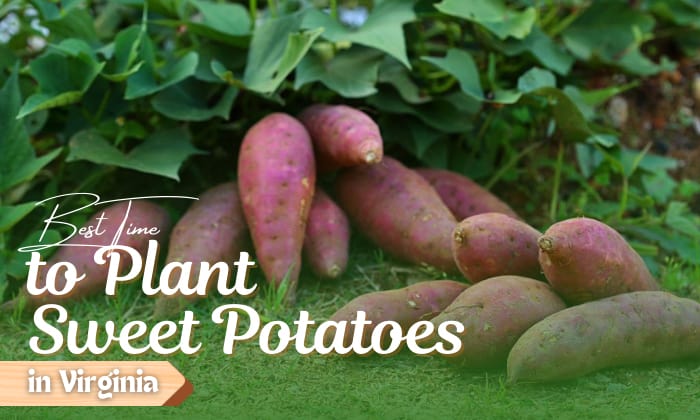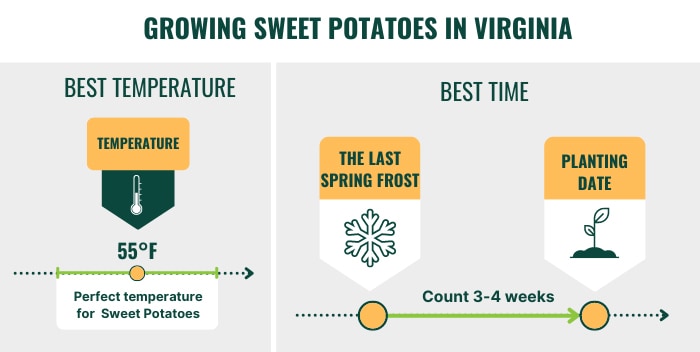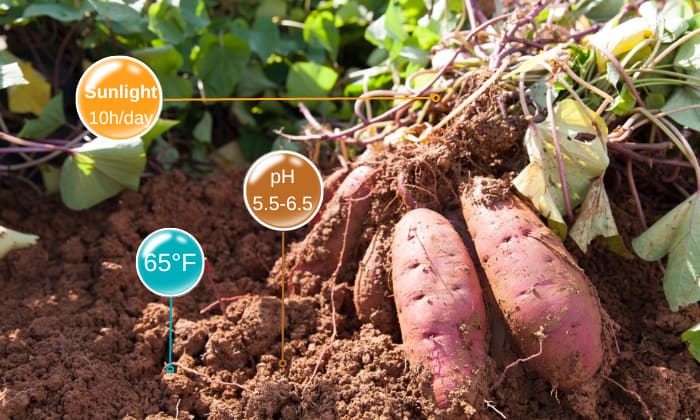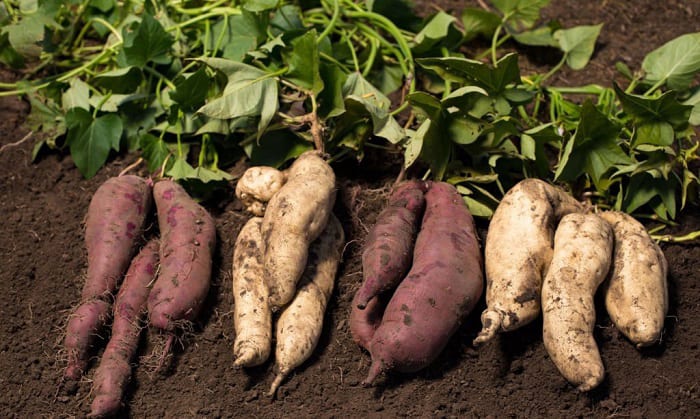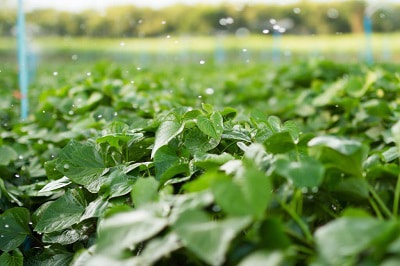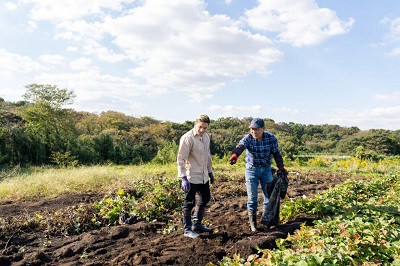Knowing exactly when to plant sweet potatoes in Virginia will depend on the region’s last frost dates. Based on the climate zone, on average, the best months for planting fall between April 5 to July 25.
Unlike regular potatoes which prefer cool climates, these tubers thrive in hot weather. They also need to be planted in soil temperature with a minimum of 65º F with lots of time under the sun to flourish. Need more tips? Keep reading.
Table of Contents
Best Time to Plant Sweet Potatoes in Virginia
When growing sweet potatoes, timing is very important since these tubers are susceptible to frost. Virginia’s climate varies from region to region so to find what month you should plant sweet potato slips depends on the frost dates.
A rough estimate is planting them three to four weeks after the last spring frost. For harvesting, you should complete it before the soil temperature reaches 55℉ during the week of the first fall frost.
While the warmer temperatures of spring and summer seasons are generally ideal for sweet potatoes, the planting calendars can vary. Check out the recommended planting dates below per hardiness zone.
- Hardiness Zone 6A: May 15 – July 5
- Hardiness Zone 6B: May 5 – July 5
- Hardiness Zone 7A: April 25 – July 15
- Hardiness Zone 7B: April 15 – July 25
- Hardiness Zone 8A: April 5 – July 25
Table of Frost Dates in Major Cities
| City | Last Frost Date | First Frost Date |
| Virginia Beach (Zone 8A) | April 3 | November 10 |
| Norfolk (Zone 8A) | March 20 | November 27 |
| Chesapeake (Zones 7B and 8A) | March 28 | November 18 |
| Arlington (Zone 7A and 7B) | April 19 | October 22 |
| Richmond (Zones 7A and 7B) | April 10 | October 30 |
Ultimately, the first and last frost dates for major cities in the table above are only averages and never constant. They can happen much later or earlier than in previous years.
Pay careful attention to the weather patterns in your area to ensure your sweet potatoes survive the frost.
Growing Sweet Potatoes in Virginia
Other than planting calendars, you also have to consider the ideal conditions sweet potatoes need to thrive.
- These tubers benefit from loose, well-draining soil but heavier soil types like clay are options as long as they’re rich in organic matter.
- Soil pH levels of 5.5-6.5 are ideal for sweet potatoes.
- Another thing to note is how sweet potatoes love warm weather so much that they need to be planted in soil with a 65°F temperature that gets plenty of sunshine.
- Give them 10 hours of daily sunlight exposure.
While it’s common to plant them outdoors, you can also grow sweet potatoes in water containers indoors. Even if you choose the indoor option, ensure the containers are in sunny spots.
If natural sunlight is out of the option or you’re in a region with shorter sun exposure, grow lights are well worth considering. If you want to go the extra mile and have better control of the growing conditions, you’re better off with growing tents.
Sweet Potatoes Varieties to Plant in Virginia
How many days it takes to grow sweet potatoes would depend on the variety but the average is typically between 80-120 days so growing these tubers requires patience and dedication.
If you’re looking for varieties that can mature relatively quicker than the rest, here are some short-season sweet potatoes you might want to check out:
- Beauregard
- Bush Porto Rico
- Centennial
- Georgia Jet
- Jewel
- Vardaman
Choosing which variety to go for will depend on your personal preferences but according to the Virginia Cooperative Extension, the best varieties for Virginia are Barker, Centennial, and Jewel.
Care and Maintenance After Planting
Sweet potatoes can take up to 150 days from planting to harvesting so it’s crucial that you take care of them properly for a bountiful harvest. Here are some essential maintenance tips you can use as a guide:
1. Watering
While sweet potatoes love moisture, they don’t do too well in waterlogged soil. In fact, they can survive better against dry spells than their flooded counterparts. Aim for a minimum of 1 in. water every week.
Make sure you stop watering 2 weeks before harvesting.
2. Weed Control
Mulching with grass clippings, leaves, and straw can help protect against weeds while preserving moisture at the same time. Just like with every plant, weeds steal away the necessary nutrients sweet potatoes need to flourish.
Make sure to weed regularly two weeks after planting.
3. Fertilizing
When it comes to fertilizer requirements, stay away from those rich in nitrogen since they can exacerbate foliage growth and stunt growth. Instead, opt for high-phosphorus liquid fertilizer and organic options like compost and manure.
4. Pest and Disease Management
While sweet potatoes are generally resilient, they are not completely immune to pests and diseases. In fact, here are some of the more common challenges faced by sweet potato growers along with their corresponding treatments:
- Aphids – Regularly spray with a solution made of water and dish soap.
- Black rot – Remove the damaged parts and cure the rest from the same root crop.
- Flea beetles – Apply a good dose of mulch.
- Stem rot – Plant resistant varsoil ph
- White rust – Destroy the diseased plants and practice crop rotation.
5. Vine Management
Sweet potatoes will grow sprawling vines as they mature. It’s not needed nor recommended to prune them. However, if their growth is going out of control, you can use a trellis or stakes to support vertical growth and even add an aesthetic touch to your garden.
Harvesting and Storing
How many days to harvest will vary on the sweet potato variety but it can take approximately 90-120 days. You can tell they’re ready when the foliage starts to yellow and wither, indicating their transition into dormancy.
- To harvest sweet potatoes, dig carefully so you don’t skin or bruise the roots. If you’re gentle enough, you can even reuse the same plant and let it grow again.
- Before you proceed to store your sweet potatoes, it’s vital to cure them properly. Right after harvest, place your tubers in a warm and humid environment with an 85°F temperature for over a week up to 10 days.
- After curing, it’s time for you to choose a cool location away from heat and sunlight, preferably a basement or a root cellar. Temperatures should be between 55–65°F. Don’t put them in the fridge as that can ruin the flavor and texture.
- If you’ve done everything properly up until this point, you can expect your cured sweet potatoes to last 5-12 months in storage.
Conclusion
The best time when to plant sweet potatoes in Virginia falls between early April to late July. But it’s not an exact science and it will depend on your region’s first and last frost dates which is why you need to stay sharp in observing the change in seasons.
We’ve discussed it all from the ideal planting calendar, and the best growing conditions, to the varieties well-suited for Virginia’s climate, along with essential care tips, and what you need to do for harvesting and storage. You should now be ready to get your hands dirty.
Best time to plant some vegetables in Virginia:

Hi, I am William – Floridayards’ digital content creator. My job is to find answers to all your concerns with thorough research and our team’s expert advice. I will also bring you honest reviews on the best products and equipment for raising your beautiful garden. Please look forward to our work!


